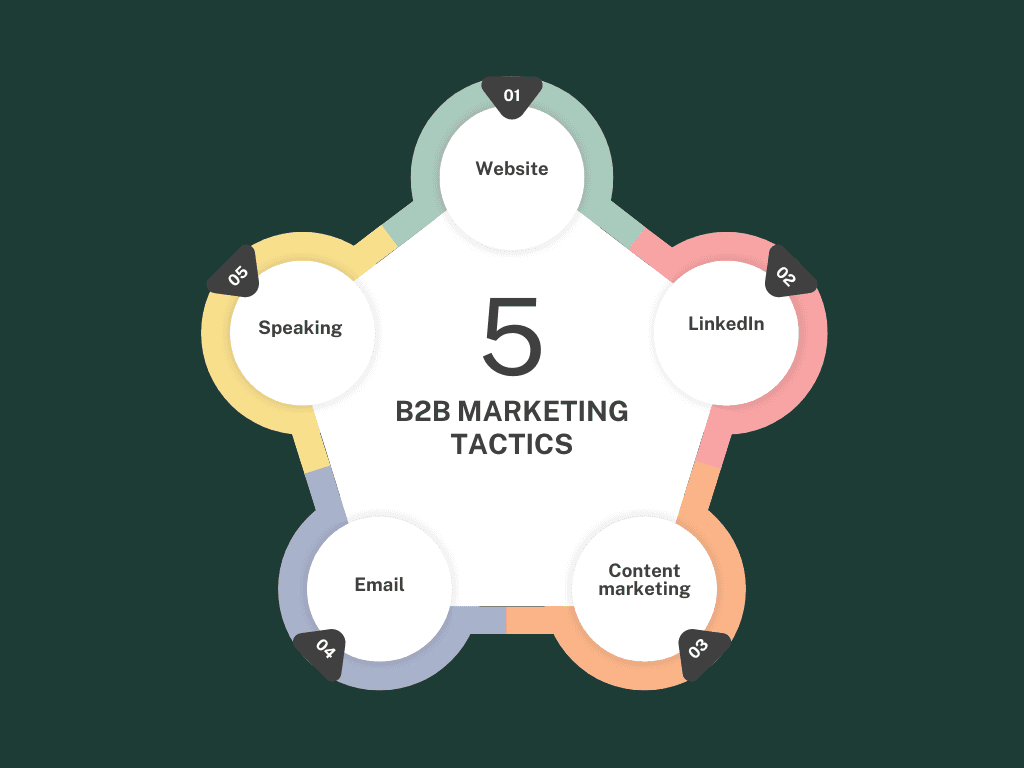B to B marketing: a beginner’s guide for consultants who want to expand beyond referrals
Sep 27, 2024
You’ve got the referrals, the reputable clients, the success story. Life’s good.
But here’s the thing: if you want to scale, branch into new service lines, or start attracting clients beyond your usual circle, relying solely on referrals won’t get you there.
That’s where B to B marketing steps in.
It’s not about ditching what’s already working; it’s about amplifying it. With a more diverse marketing strategy you can create consistent demand, expand your reach and put growth in your control…not your networks’.
In this guide, I’ll break down the basics of B to B marketing and show you what tactics you can use to build authority, bring in higher value clients and grow your consultancy to the next level.
Let’s get into it.
What is B to B marketing and why should I care?
B to B marketing (also called business-to-business marketing or B2B marketing) is how consultants like you promote your services to other businesses, specifically targeting decision makers like CEOs, department heads and executives.
Unlike B2C (business-to-consumer), where emotions drive quick decisions, B to B marketing is about building trust and demonstrating value over time.
It involves dealing with multiple decision makers, who all have their own agendas and concerns. The best B2B marketers develop different pieces of marketing aimed to address various buying committee concerns (like a LinkedIn post aimed at the CEO and a case study on your website that speaks to the HR Director).
So what does B to B marketing really involve? It can be some or all of the below…
Thought leadership content (case studies, white papers, blogs)
Email outreach and newsletters
LinkedIn networking
SEO optimised website and content
Webinars
Podcasting
Speaking gigs
Advertising.
Seth Godin nailed why corporate buyers actually pull the trigger.
They want to:
Avoid risk
Gain praise
Dodge hassle
Make a profit
Grab a bit of power.
To be impactful, your marketing needs to talk to at least three of these motivations.
Still with me?
Good, because here’s where most consultants fall short – they forget that B to B marketing is all about showing value.
Not just talking to functional stuff like saving your prospect money or improving their productivity, but strategic value like helping them look like rock stars in their own organisations.
This graphic shows the different types of value B2B decision makers seek when choosing services, grouped into four categories: functional, ease of doing business, individual value and inspirational value.

It’s not enough to aim all of your marketing efforts on one key driver. You need to be more strategic than that.
The shift from referrals to strategy
Referrals are gold, especially when you’re a boutique or one-person consultancy.
They’ve helped you build a community of clients, peers and helped you establish yourself in the industry. A lot of businesses prefer to work with trusted suppliers – referrals are important in the consultancy world.
But they can only take you so far. And they’re unpredictable.
What happens when you want to launch a new service? Or move into a specific industry? Or grow beyond your current network?
If economic pressures are squeezing the market, can you predict where your next client is coming from?
Often referred clients aren’t the exact people you want to work with, or they try to bypass your process.
So, yes referrals are important, but if you want a scalable, sustainable consultancy they shouldn’t be the lifeblood of your business.
Adopting a structured B2B marketing strategy could supercharge your efforts.
Not only does it bring in different types of leads and higher value clients, but it also increases your visibility, which can lead to more referrals. The more people who see your expertise through blog posts, case studies or LinkedIn content, the more likely they are to recommend you to their contacts.
Think of it like building a marketing machine that keeps referrals flowing, while also creating new opportunities.
This doesn’t mean you have to invest in a multi-channel mega marketing strategy that an expensive agency manages for you.
Not at all.
There are foundational steps you can take today that will start to help you take control of your growth, rather than waiting for the next recommendation to land in your inbox.
It’s about balancing what makes an impact with your target audience, maintaining a personal touch, your budget and what you can consistently commit to.
As you scale, your investment in marketing will rise…as should the ROI. As the old adage goes, ‘you have to spend money to make money’.
Key components of B to B marketing for consultants
Before diving into any new marketing activity, you need a plan.
Whether you’re DIYing it or getting help from a marketing consultant, a well thought out strategy stops you from wasting time on tactics that don’t align with your goals. Think of it as your roadmap. Without it, you’re just guessing.
A strong plan should start with clear objectives; these should guide every marketing move you make.
Step 1: define your objectives
Your objectives are the foundation of your marketing plan. Get really clear on what you want to achieve. It could be to…
Expand into a new market
Increase value of new clients by 25%
Land more speaking opportunities
Build a more sustainable pipeline
Launch a new offer successfully.
Objectives give your marketing direction and help you measure success.
Step 2: identify your target audience
Who exactly are you trying to reach? The more specific, the better.
Define your audience based on:
Industry
Their role
What they care about
Their pain points and challenges you can help solve
Step 3: analyse your competitors
Before coming up with marketing ideas, look at what your competitors are doing. This helps you spot gaps and opportunities to differentiate.
Are they blogging, using LinkedIn, running webinars, or focusing on paid ads?
Step 4: choose your channels
Once you know your audience and objectives, decide which marketing channels make sense for your business. Where are your audience?
Hint: it’s likely more than one place. Especially if you’re targeting bigger corporates or government organisations with procurement or buying committees.
At the start of your marketing journey, it’s best to focus on a few channels that offer the most direct impact. Quality over quantity.
Website & SEO: Your website is your home base. It needs to talk to your authority, expertise and recent results. That means social proof, case studies and clear calls-to-action. At the very least, you’ll want basic SEO optimisation so searchers can find you on Google.
Content marketing: Blog posts, case studies, white papers and featured guest posts can help you establish authority and showcase expertise.
LinkedIn: Your primary platform for online networking and longer thought leadership articles. Post regularly and engage with decision makers to build connections.
Email marketing: Personalised emails are great for nurturing relationships and driving long term business growth. Build a list and send a regular newsletter.
Webinars & speaking gigs: Hosting or speaking at events can build credibility, visibility and attract new leads.
Paid ads: Google and LinkedIn ads can be effective but usually require a well defined audience and are popular with consultants who have more mature marketing capabilities.
Step 5: don’t forget networking!
Networking is often overlooked as a formal marketing tactic, but it’s essential. Whether in person or online, it’s how you grow your influence and find new opportunities.
Boutique and independent consultants can leverage networking as one of the most cost-effective ways to generate leads and referrals.
How to get started today (without overwhelming yourself)
You don’t need a 50 page marketing plan or to be on every platform under the sun. Here’s where to start if you’re serious about scaling, without the burnout.
Audit what you’re already doing: What’s working? What’s not? Look at your website, LinkedIn presence, any email campaigns. Are they bringing in leads or just taking up space? Get clear on what’s giving you the best ROI and do more of that.
Set a clear, specific goal: No, “get more clients” isn’t a goal. “Sign 5 new clients at 15% increased fee in the next 3 months”? Now we’re talking. A sharp, focused objective gives direction.
Choose one marketing channel (and nail it): Don’t try to be everywhere at once…focus. LinkedIn is often the sweet spot for consultants. Start posting valuable articles, snappy posts that’ll get eyeballs and engage with decision makers regularly to get your name in front of the right people. Once you’ve mastered one channel, expand from there.
And if you know you don’t have the time to commit to marketing, or it’s just not fun for you…hire a B2B marketing consultant to help!
There are so many of us out there, from cost-effective marketing freelancers to senior copywriters with over a decade of experience and agencies (yes, good ones exist).
Ready to grow beyond referrals?
Referrals will always play a part, but if you’re aiming for real growth – new clients, new services, more stability – you need a B to B marketing strategy.
A smart strategy doesn’t just bring in more leads; it attracts higher value clients, builds long-term relationships and strengthens your brand’s authority. With consistent marketing, you’re creating your next opportunity.
Want to position your consultancy for bigger, better things?
I offer a small number of 1:1 ‘Plot Development’ sessions per year to select clients, where I review your marketing and tell you exactly what to do next. I’ve got one spot left for 2024, so if you want to snap it up, reach out today.



